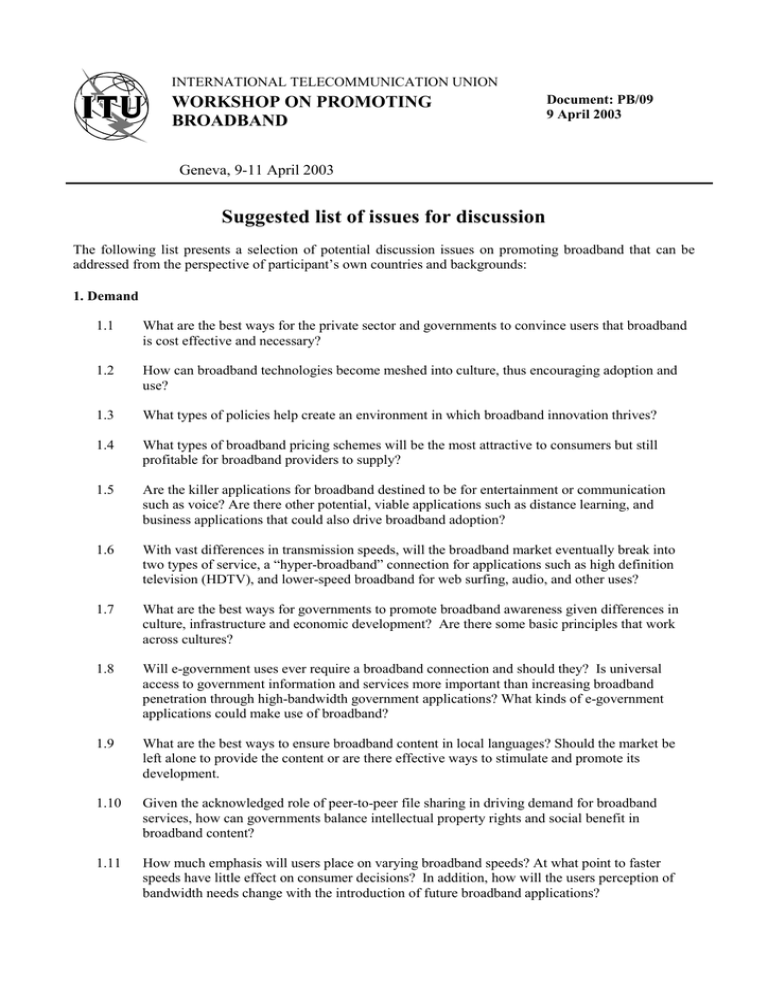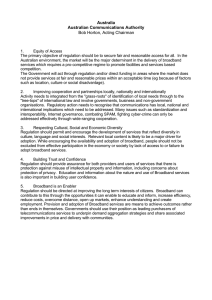Suggested list of issues for discussion WORKSHOP ON PROMOTING BROADBAND
advertisement

INTERNATIONAL TELECOMMUNICATION UNION WORKSHOP ON PROMOTING BROADBAND Document: PB/09 9 April 2003 Geneva, 9-11 April 2003 Suggested list of issues for discussion The following list presents a selection of potential discussion issues on promoting broadband that can be addressed from the perspective of participant’s own countries and backgrounds: 1. Demand 1.1 What are the best ways for the private sector and governments to convince users that broadband is cost effective and necessary? 1.2 How can broadband technologies become meshed into culture, thus encouraging adoption and use? 1.3 What types of policies help create an environment in which broadband innovation thrives? 1.4 What types of broadband pricing schemes will be the most attractive to consumers but still profitable for broadband providers to supply? 1.5 Are the killer applications for broadband destined to be for entertainment or communication such as voice? Are there other potential, viable applications such as distance learning, and business applications that could also drive broadband adoption? 1.6 With vast differences in transmission speeds, will the broadband market eventually break into two types of service, a “hyper-broadband” connection for applications such as high definition television (HDTV), and lower-speed broadband for web surfing, audio, and other uses? 1.7 What are the best ways for governments to promote broadband awareness given differences in culture, infrastructure and economic development? Are there some basic principles that work across cultures? 1.8 Will e-government uses ever require a broadband connection and should they? Is universal access to government information and services more important than increasing broadband penetration through high-bandwidth government applications? What kinds of e-government applications could make use of broadband? 1.9 What are the best ways to ensure broadband content in local languages? Should the market be left alone to provide the content or are there effective ways to stimulate and promote its development. 1.10 Given the acknowledged role of peer-to-peer file sharing in driving demand for broadband services, how can governments balance intellectual property rights and social benefit in broadband content? 1.11 How much emphasis will users place on varying broadband speeds? At what point to faster speeds have little effect on consumer decisions? In addition, how will the users perception of bandwidth needs change with the introduction of future broadband applications? 2. Supply 2.1 While a market may be considered competitive based on the number of broadband providers, often there is little or no choice for consumers for technical reasons. How can governments ensure the market still functions competitively? 2.2 As the cost of fibre networks approach copper, should new developments and infrastructure always be fibre based? Or, is wireless becoming viable as a long-term substitute for fibre? 2.3 Community access centres are a viable way to bring broadband to remote areas. However, what types of connections are best for these centres? It is more important to immediately connect these areas, even if the connection speeds can not be upgraded in the future, or should governments invest in more expensive lines to the centres that can handle future growth and expansion following an expanding point of profitability (EPOP) approach? 2.4 Governments can participate in broadband promotion at all levels (e.g. national, regional, city, community). Is it better to start at the national government level and work down or promote from the local government on up? 2.5 How can broadband providers ensure consistent quality of service (QoS), necessary for videoon-demand, IP telephony, and other time-critical broadband applications? 2.6 Will there be a further consolidation of telecommunication services to the point where all data services (e.g. phone, Internet, TV) come across the same high-speed broadband line? What are the implications for the market? 2.7 How important is facilities-based competition in the rollout of broadband and how can governments foster it? What kinds of problems are likely to arise and how have they been efficiently dealt with? 2.8 Which network technologies have been the most successful in expanding broadband access and are there others that show promise? (Digital subscriber lines (DSL), cable, fixed wireless, satellite, utility lines, wireless local area networks (WLAN), next-generation mobile networks)? 3. Other 3.1 What role might ITU usefully play in promoting broadband? Outside of workshops and publications, are there other ways ITU can help promote broadband adoption around the world? 3.2 What will be the impact of increased broadband penetration on the economy? Will areas with high broadband connectivity be more successful than others in attracting investment? Will higher penetration rates increase productivity? 3.3 Will advances in compression technologies decrease the need for higher-speed broadband? As processor speed increases and compression capability expands, will users continue to demand large amounts of bandwidth? 3.4 What is an effective way to measure how well economies are advanced in terms of infrastructure? When speeds and services vary widely from country to country should comparisons be done on price per Mbit/sec? Or, are comparisons of entry-level products a better measure?


